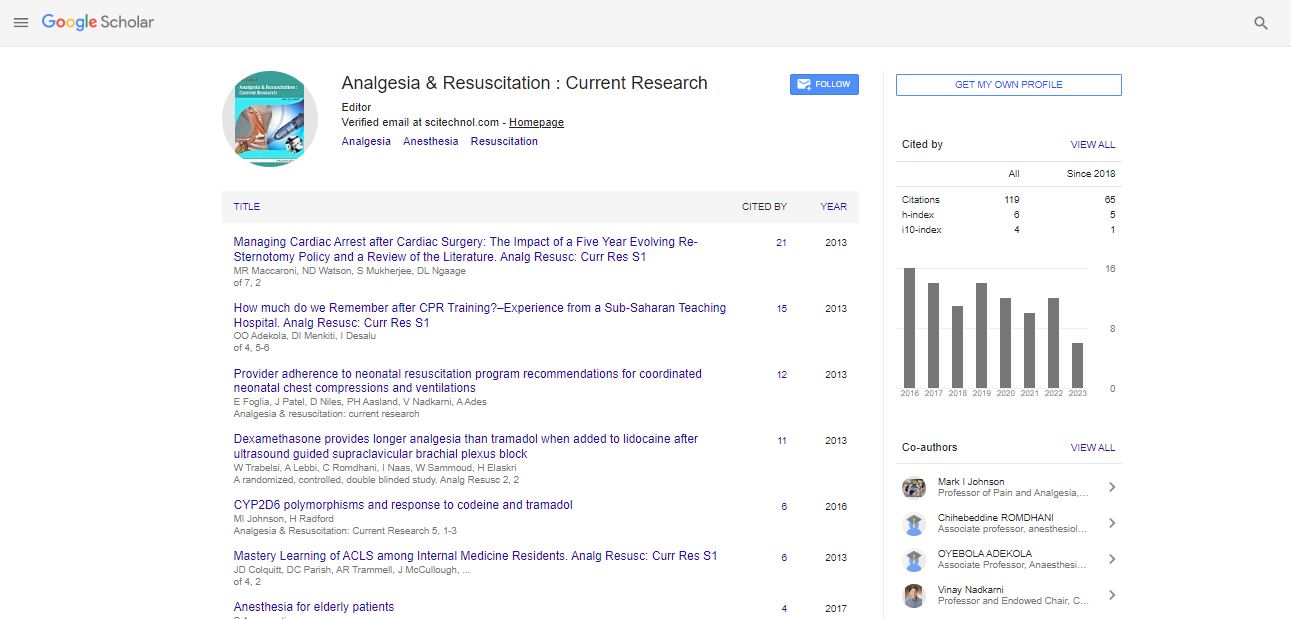Opinion Article, Analg Resusc Curr Res Vol: 12 Issue: 1
Neuropathic Pain: Cause and Treatment Option
Yevgei Crespo*
1Department of Neurology, Ataturk University School of Medicine, Erzurum, Turkey
*Corresponding Author: Yevgei Crespo
Department of Neurology, Ataturk
University School of Medicine, Erzurum, Turkey
E-mail: yevgeicrespo@gmail.com
Received date: 01-Feb-2023, Manuscript No. ARCR-23-93257;
Editor assigned date: 03-Feb-2023, PreQC No. ARCR-23-93257 (PQ);
Reviewed date: 17-Feb-2023, QC No. ARCR-23-93257;
Revised date: 24-Feb-2023, Manuscript No. ARCR-23-93257(R);
Published date: 03-Mar-2023, DOI: 10.4172/ 2324-903X.1000102.20
Citation: Crespo Y (2023) Neuropathic Pain: Cause and Treatment Option. Analg Resusc: Curr Res 12:1.
Description
Neuropathic pain is a type of chronic pain that occurs as a result of damage or dysfunction in the nervous system. Unlike other types of pain, neuropathic pain is not a direct response to tissue damage or inflammation. Instead, it is the result of abnormal signals sent by damaged or dysfunctional nerves. Neuropathic pain can be difficult to diagnose and treat and can have a significant impact on a person's quality of life.
Causes of Neuropathic Pain
There are several potential causes of neuropathic pain. Some of the most common causes include:
Nerve damage or injury: Nerve damage or injury can occur as a result of trauma, surgery, or other medical conditions such as diabetes or multiple sclerosis.
Infections: Certain infections, such as shingles or HIV, can damage nerves and lead to neuropathic pain.
Cancer: Some types of cancer, as well as cancer treatments such as chemotherapy, can cause nerve damage and lead to neuropathic pain.
Medications: Certain medications, such as chemotherapy drugs, can cause nerve damage and lead to neuropathic pain.
Alcoholism: Chronic alcohol abuse can lead to nerve damage and neuropathic pain.
Treatment Options for Neuropathic Pain
The treatment of neuropathic pain can be challenging, as it often does not respond well to traditional pain medications. However, there are several treatment options available, including below.
Medications: Certain medications, such as antidepressants and anticonvulsants, can be effective in treating neuropathic pain. These medications work by altering the way that the nervous system processes pain signals.
Nerve blocks: Nerve blocks involve injecting an anesthetic or steroid medication into a specific nerve or group of nerves, which can provide temporary relief from neuropathic pain.
Electrical stimulation: Electrical stimulation, such as Transcutaneous Electrical Nerve Stimulation (TENS) or spinal cord stimulation can be effective in reducing neuropathic pain.
Physical therapy: Physical therapy can help to improve strength, flexibility, and coordination, which can reduce the impact of neuropathic pain on daily activities.
Cognitive-Behavioral Therapy (CBT): CBT can help patients to develop coping strategies and improve their ability to manage neuropathic pain.
Causes
Nutritional deficiencies: Deficiencies in vitamins or minerals, such as B12 or folate, can cause damage to the nervous system and result in neuropathic pain.
Trauma: Physical trauma, such as a car accident or sports injury, can cause nerve damage and result in neuropathic pain.
Genetic disorders: Certain genetic disorders, such as Charcot- Marie-Tooth disease, can cause nerve damage and result in neuropathic pain.
Idiopathic: In some cases, the cause of neuropathic pain is unknown.
Conclusion
Neuropathic pain is a complex and often chronic condition that can have a significant impact on a person's quality of life. Understanding the causes of neuropathic pain is essential for effective diagnosis and treatment. By working with healthcare providers and exploring a range of treatment options, patients with neuropathic pain can improve their quality of life and minimize the impact of pain on their daily activities. Additionally, preventative measures such as maintaining a healthy lifestyle and avoiding known risk factors can help to reduce the risk of developing neuropathic pain.

